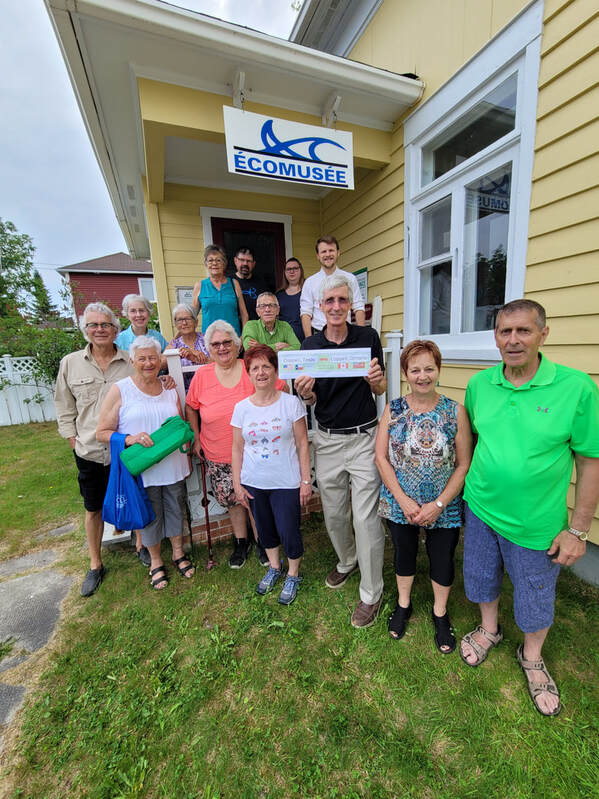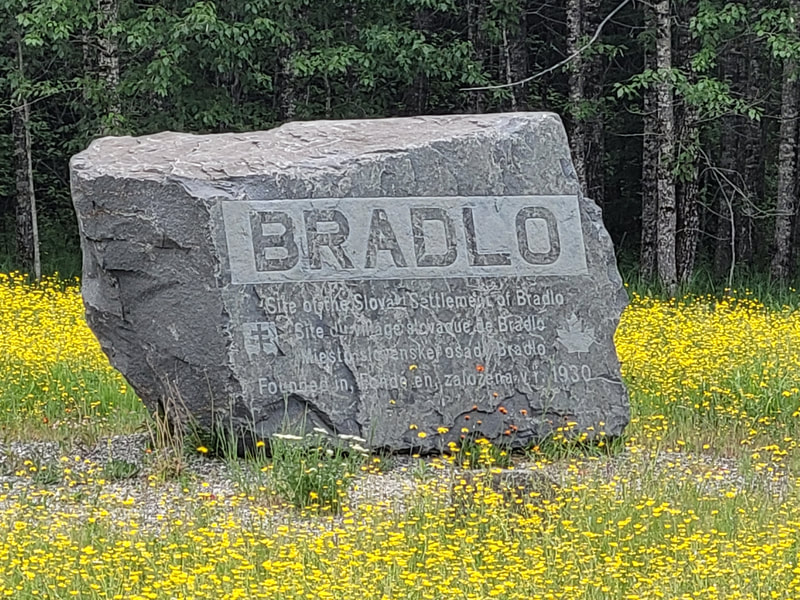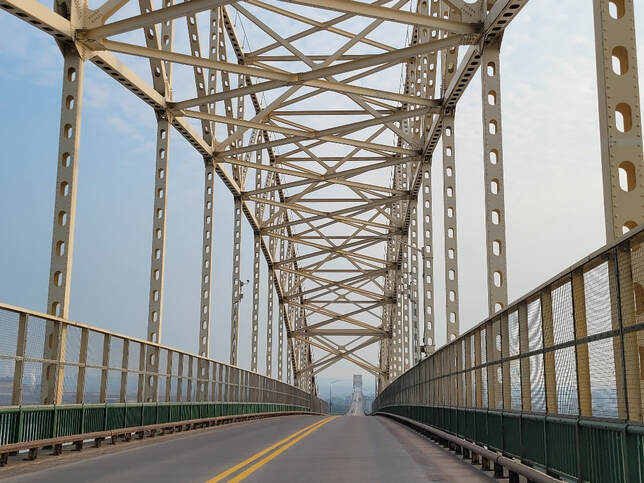A ROAD TRIP FROM
COPPELL, TEXAS TO COPPELL, ONTARIO
COPPELL, TEXAS TO COPPELL, ONTARIO
This web page documents the road trip taken by Phil & Lois LaBerge from Coppell, Texas to Coppell, Ontario Canada in June of 2023. The reason for making the 1,900 mi (3,000 km) journey was to meet the people who live in Coppell, Ontario, share stories, and possibly make some new friends. It was a fascinating trip.
Coppell, Ontario
Googlemaps: Coppell, Ontario
The house that served as Coppell Station with Coppell written on the side of it (shown on Google maps) is unfortunately no longer there. The convent, stores and other buildings have long since disappeared and it is now just a collection of a few houses. Some are in good condition, and some aren't. No sign marks the village as you approach it. Its history now rests in the memories of those who once lived there and the few who remain.
The house that served as Coppell Station with Coppell written on the side of it (shown on Google maps) is unfortunately no longer there. The convent, stores and other buildings have long since disappeared and it is now just a collection of a few houses. Some are in good condition, and some aren't. No sign marks the village as you approach it. Its history now rests in the memories of those who once lived there and the few who remain.
To learn more about the history of the village of Coppell, Ontario, read this article: Lost Village of Coppell (Village disparue Coppell).
Hearst, Ontario
Googlemaps: Ecomusée, Hearst
At 10 am on Saturday, June 24th, we met at the Ecomusée in Hearst with many current and former residents of Coppell, Ontario to get acquainted share stories before driving 15 minutes south to Coppell. Here are a few of the photos.
At 10 am on Saturday, June 24th, we met at the Ecomusée in Hearst with many current and former residents of Coppell, Ontario to get acquainted share stories before driving 15 minutes south to Coppell. Here are a few of the photos.
Bradlo, Ontario
Googlemaps: Bradlo
After our meeting at the Ecomusée in Hearst, most of the group got in their cars and we followed each other down towards Coppell. Our first stop along the way was a monument marking what was the town of Bradlo. It was a small town of Slovak and Fin immigrants who settled there. Interestingly, one of the many people who I talked to before making our road trip was Ernie Bies who wrote the article, Bradlo, Ontario : A Slovak Colony Carved from the Boreal Forest.
After our meeting at the Ecomusée in Hearst, most of the group got in their cars and we followed each other down towards Coppell. Our first stop along the way was a monument marking what was the town of Bradlo. It was a small town of Slovak and Fin immigrants who settled there. Interestingly, one of the many people who I talked to before making our road trip was Ernie Bies who wrote the article, Bradlo, Ontario : A Slovak Colony Carved from the Boreal Forest.
Riviére de Coppell
Googlemaps: Riviére de Coppell
The Coppell River (Riviére de Coppell) is located at the south end of Coppell and north of Meade about 700 ft. south of the Payeur Family Cross. It is also named the Obijou River which I have to believe is named after the Ojibwe (First Nation) people. Below is the road sign.
The Coppell River (Riviére de Coppell) is located at the south end of Coppell and north of Meade about 700 ft. south of the Payeur Family Cross. It is also named the Obijou River which I have to believe is named after the Ojibwe (First Nation) people. Below is the road sign.
Lac de Coppell, Ontario
Googlemaps: Lac de Coppell
Lake Coppell (Lac de Coppell) is just east of the village on Concession Rd. 6&7. It is a very nice sized lake with some picnic areas, a sandy beach and houses along the north side of it.
Lake Coppell (Lac de Coppell) is just east of the village on Concession Rd. 6&7. It is a very nice sized lake with some picnic areas, a sandy beach and houses along the north side of it.
Payeur Family Cross
Googlemaps: Payeur Family Cross
There is a large cross located just south of the village where the Payeur family home used to be located until the tragic fire which occurred on the morning of September 13, 1928. Six of the seven children of the Payeur family died int he tragic fire. The one who survived was the father of Gérard Payeur who I met with.
There is a large cross located just south of the village where the Payeur family home used to be located until the tragic fire which occurred on the morning of September 13, 1928. Six of the seven children of the Payeur family died int he tragic fire. The one who survived was the father of Gérard Payeur who I met with.
You can read about it below. What struck me is how the entire history of a family and its future generation could be struck by a single tragic event and how lucky we are that at least Gérard's father survived.
Sainte-Elizabeth de Hongrie Cross
Google Maps: Sainte-Elizabeth de Hongrie Cross
Located at the southeast corner of the village of Coppell there is a statue of Sainte-Elizabeth-de-Hongrie. It has on it a list of the first pioneers who settled there:
Located at the southeast corner of the village of Coppell there is a statue of Sainte-Elizabeth-de-Hongrie. It has on it a list of the first pioneers who settled there:
Wawa, Ontario
Googlemaps: Wawa
Wawa is located on the easter end of Lake Superior and marks the midway point of the Trans-Canada Highway.
In 1897, there was a brief gold rush in Wawa which soon ended. When they were mining for gold, however, they discovered lots of iron ore. Some of the samples made their way to Francis Hector Clergue who was an entrepreneur in Maine who saw the potential of forming an iron empire in Sault-Ste-Marie. Francis Clergue went on to be the founder of St. Mary's Paper, Algoma Steel, and the Algoma Central Railway which was built from Sault-Ste-Marie to Hearst.
Wawa is located on the easter end of Lake Superior and marks the midway point of the Trans-Canada Highway.
In 1897, there was a brief gold rush in Wawa which soon ended. When they were mining for gold, however, they discovered lots of iron ore. Some of the samples made their way to Francis Hector Clergue who was an entrepreneur in Maine who saw the potential of forming an iron empire in Sault-Ste-Marie. Francis Clergue went on to be the founder of St. Mary's Paper, Algoma Steel, and the Algoma Central Railway which was built from Sault-Ste-Marie to Hearst.
Sault-Ste-Marie, Ontario
Googlemaps: Sault-Ste-Marie, Ontario
After crossing the bridge, we went to the home of Lise Groleau and her husband Robert Lecours. Lise was born and raised in Coppell, Ontario and told us some wonderful stories about growing up there. Her father had a very large dairy farm which got recognition for the quality of their operation. I will be posting more about our conversation here soon.
After crossing the bridge, we went to the home of Lise Groleau and her husband Robert Lecours. Lise was born and raised in Coppell, Ontario and told us some wonderful stories about growing up there. Her father had a very large dairy farm which got recognition for the quality of their operation. I will be posting more about our conversation here soon.
COPPELL HISTORICAL SOCIETY, P.O. BOX 1871, COPPELL, TX 75019
[email protected]
The Coppell Historical Society is a 501 (c)(3) non-profit organization































